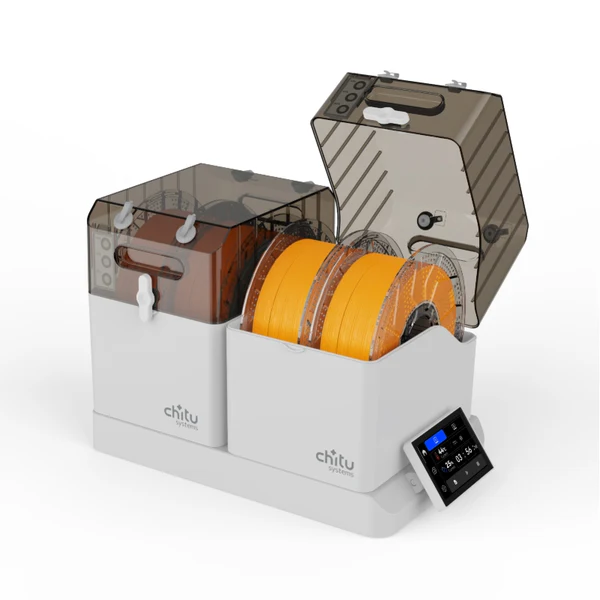Noticing bubbles, inconsistent textures, and messed-up areas on your 3D printed parts isn’t normal. However, that doesn’t mean you’re alone. Hundreds of thousands of people around the world experience this issue, but most overlook the primary reason behind 3D print bubbling.
Some would try to buy the most expensive filaments, while others would attempt to adjust the slicer settings; however, the main problem is a single issue: moisture. Wet filament is the biggest threat that takes away your 3D print’s true potential.
In this guide, we will discuss the solution to why your 3D print is bubbling and how to achieve consistent and improved prints.
Why is 3D Printing Bubbling?
Before diving deep into the fixes, let’s first talk about what bubbling exactly looks like. So, to sum it up, bubbling can incorporate tiny holes or craters on the print surface. During the 3D printing process, you might hear sounds of hissing or popping, which is one of the significant signs that bubbling is about to happen.
Moreover, it can also manifest as blobs or inconsistent lines. Only in extreme cases of humidity can the bubbling cause the complete layer to fall off, stringing, and even clog the nozzle, potentially damaging your 3D printer.
But what exactly causes this mess? Your answer is moisture.
The Real Villain: Moisture in Filaments
3D printing filaments are labeled as hygroscopic. This means that the filaments can absorb humidity from the air, causing them to bubble if it is not stored correctly. There are filaments, such as Nylon, PETG, TPU, and others, that are highly hygroscopic.
Then we have PLA, which is often considered less moisture-absorbing; however, even that requires a filament dryer in areas where the humidity is extremely high.
So, how exactly does a wet filament cause issues in 3D printing? Firstly, when you heat the wet filament in the printer’s hotend, the absorbed water instantly turns into steam.
This steam causes micro-explosions inside the extruder, and that pushes bubbles out with the filament’s molten plastic, creating proper bubbles. Aesthetically, your 3D prints will not only look unappealing but also cease to serve their intended purpose.
So, why exactly is moisture a danger for 3D printing in general?
Dangers of Moisture for 3D Printing
- Imperfect Surface:
The biggest issue that moisture causes is with the surface itself. Thanks to the steam, the extruded filaments have gas pockets that will result in rough, uneven, and cratered textures. Moreover, your print will appear odd, especially if you’re creating detailed models or something that requires precise details.
- Poor Layer Adhesion:
When we introduce bubbles into the equation, it can interfere with the consistent flow of the filament, creating micro-gaps between the layers. The dangers of these gaps include brittle prints, some parts that can snap or even be destroyed under minor stress, and a reduction in overall strength in functional prints.
- Inconsistent Print:
Streets tend to expand quite violently, making your filament move out too quickly or irregularly. This creates several other issues. For example, you might notice blobs, some layers may be under-extruded, and over time, your nozzle can become clogged, which can damage your 3D printer as well.
All in all, the dangers of moisture for 3D printing are much more than just the three we’ve mentioned above. But when it comes to bubbling in general, it’s a moist filament. Whether it’s wet due to water or moisture, bubbling will be caused.
Fixing 3D print Bubbling
Now that we understand the dangers of moisture, let’s also discuss how to address bubbling. While the bubbled 3D print cannot be reversed, you can be careful with the next prints. The key here is to remove moisture, as most problems with your filaments are caused by moisture damage. Here is the best fix for reducing moisture.
Use a Filament Dryer
The most reliable solution for all moisture issues is to use a dedicated filament dryer. While there are numerous brands on the market, we recommend choosing Chitu Systems’ FilaPartner E1.
This filament dryer maintains a controlled heat environment with consistent airflow, ensuring your filaments remain dry and free from moisture-related issues.
Here are some of the benefits you get by choosing the FilaPartner E1:
- Two-Chambered Design: With FilaPartner, you have two chambers. This means that you can store up to 4 spools of filaments to dry them at the optimal temperature. Both chambers can also operate at different temperatures, making it ideal for drying.
- Adjustable Temperature Range: The temperature range of this filament dryer is also adjustable. For example, you can adjust the temperature from 45 degrees to 70 degrees Celsius, making it ideal for controlling the overall temperature.
- Other Features: What’s amazing about a filament dryer like FilaPartner E1 is that it comes with sensors like a temperature and humidity checker. So, when you are drying your filament, you have full control.
A filament dryer is the best solution for anyone who is looking to get rid of moisture permanently. While there are other DIY methods, we still recommend that you choose a dedicated dryer because it is made specifically for the purpose of eliminating moisture.
You can even reverse the damage moisture has done after drying it using a filament dryer. Rest, after you keep your filaments dry, your 3D prints won’t have any bubbling issues.
Final Verdict
Bubbling can ruin the flow of your 3D prints, but with a filament dryer, you can eliminate the core of what causes bubbles, and that is moisture. Moreover, if you’re looking for the highest quality 3D printer accessories, visit Chitu Systems product catalog.

